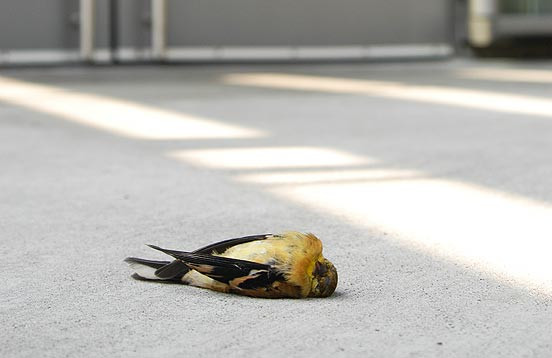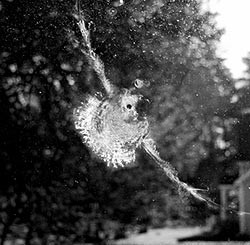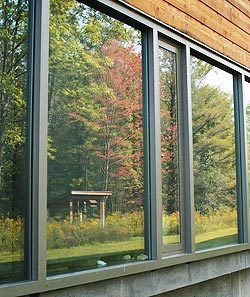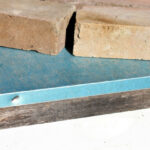Bird collisions with windows are a significant threat to avian populations. Every year, millions of birds in the U.S. and worldwide are injured or killed when they fly into glass windows. These collisions happen because birds often perceive reflections in glass as real landscapes or see through windows to indoor plants, not realizing the solid barrier. Understanding why these collisions occur and implementing effective solutions is crucial for bird conservation right in our own backyards and communities.
 American Goldfinch killed by window strike, highlighting the danger of window collisions for birds.
American Goldfinch killed by window strike, highlighting the danger of window collisions for birds.
Even if a bird appears to fly away after hitting a window, it may have sustained internal injuries. Daniel Klem, a researcher who has studied this issue for decades, emphasizes that windows are indiscriminate killers, affecting both healthy and vulnerable birds. Fortunately, there are many proven methods to significantly reduce window strikes and make your home or building safer for birds. Experts like Christine Sheppard from the American Bird Conservancy, and organizations like the Fatal Light Awareness Program (FLAP), have dedicated extensive research to this problem and offer valuable guidance on prevention.
Why Birds Collide With Windows: Understanding the Danger
There are primarily two types of window collisions: daytime and nighttime.
During the day, birds are deceived by reflections. Windows mirror the surrounding environment, especially vegetation and sky. Birds mistake these reflections for continuous habitat and attempt to fly through them, resulting in impact with the glass. Furthermore, they may see through windows into indoor spaces with plants or outdoor vegetation visible on the other side, creating the illusion of a clear flight path.
 Window imprint left by a Mourning Dove, illustrating how birds perceive windows as open space.
Window imprint left by a Mourning Dove, illustrating how birds perceive windows as open space.
At night, artificial lights pose a different danger. Nocturnal migrating birds, which include most songbirds, are disoriented by urban lights, especially during low visibility conditions like fog or cloud cover. Lights can draw them off their migratory routes, causing them to circle in brightly lit areas, increasing the risk of collision with lighted buildings and windows. Organizations like BirdCast and FLAP are actively working to raise awareness about this issue and promote “Lights Out” initiatives.
Another, less common, reason for window strikes is territorial behavior. In spring, birds, especially males, may see their reflection in a window and perceive it as a rival. They may repeatedly attack their reflection, which, while sometimes bothersome, is usually not as dangerous to the bird as a full-force collision with a window mistaken for open space. Many solutions for preventing collisions also deter these territorial attacks.
Effective Ways to Safeguard Your Windows for Birds
The first step in making your windows bird-safe is to identify the most hazardous ones. Large picture windows, corner windows, and windows near bird feeders are often high-risk. To assess the danger, go outside and observe your windows from a bird’s perspective. If you see reflections of trees, bushes, or sky in the glass, or if you can see through the window to vegetation on the other side, these windows pose a collision risk.
 Reflection of trees in a window, a common cause of bird collisions as birds mistake reflections for real vegetation.
Reflection of trees in a window, a common cause of bird collisions as birds mistake reflections for real vegetation.
Here are practical treatments for existing windows to prevent bird strikes:
Treatments for Existing Windows
To be effective, window treatments need to break up the reflection or visual transparency of the glass. For smaller birds, markings should be spaced no more than 2 inches apart horizontally and vertically. For larger patterns like Acopian BirdSavers, spacing up to 4 inches may be effective due to their increased visibility. Always apply treatments to the outside surface of the window.
-
Paint or Soap: Using tempera paint or soap to mark the exterior of your windows is a cost-effective and durable solution. Create a grid pattern with 2×2 inch squares, or design decorative patterns or artwork.
-
Decals, Stickers, and Tape: Apply decals, stickers, sun catchers, mylar strips, or masking tape to the outside of the glass. Remember, effectiveness depends on close spacing. Hawk silhouettes alone are not effective deterrents. A few widely spaced stickers on a large window will not prevent collisions; most of the glass area needs to be covered with narrow gaps.
-
Dot Patterns and Specialized Tapes: Products like Feather Friendly offer long-lasting tapes with pre-spaced dot patterns, simplifying application and ensuring correct spacing for effective bird collision prevention.
-
Acopian BirdSavers (Zen Curtains): These consist of cords hung vertically across the window’s exterior. Spaced appropriately, they are highly effective and aesthetically pleasing. The Cornell Lab of Ornithology headquarters uses Acopian BirdSavers to protect its windows. You can purchase pre-made BirdSavers or create your own.
-
Screens: Installing mosquito screens over windows provides excellent protection, as long as they are mounted externally and cover the entire window surface.
-
Netting: Covering windows with netting on the outside, positioned at least 3 inches from the glass and tautly stretched, can effectively bounce birds away before impact. Small mesh netting (around 5/8 inch) is ideal to prevent entanglement. Netting can be attached to a frame for easy installation and removal.
-
One-Way Transparent Film: Films like Collidescape are applied to the exterior of windows and allow people inside to see out while making the window appear opaque to birds on the outside. These films can also reduce sunlight and potentially lower cooling costs.
Solutions for New Homes and Remodels
If you are building a new home or replacing windows, consider these preventative measures:
-
External Shutters: Install external shutters and close them when rooms are unoccupied or when daylight or views are not needed. Shutters also offer energy-saving benefits.
-
External Shades or Awnings: Install awnings or sunshades to block reflections. Remote-controlled options offer convenience.
-
Bird-Friendly Window Options: For new construction, explore windows with built-in screens on the exterior.
-
Interior Vertical Blinds: Use interior vertical blinds and keep the slats partially closed to break up reflections.
-
Minimize Visual Pathways: Avoid creating straight visual paths through your house to outdoor greenery or sky. Windows on opposite walls that align can create the illusion of a continuous open passage. Closing interior doors or using shades can disrupt these pathways.
Lights Out: Addressing Nighttime Collisions
“Lights Out” initiatives are gaining momentum in cities across the U.S. and beyond. Reducing unnecessary nighttime lighting in urban environments is critical for protecting migrating birds. Turning off non-essential lights in buildings and using downward-facing outdoor lighting significantly reduces the hazards posed by artificial light at night. Even with community efforts, homeowners should still implement window collision prevention methods, as residential windows also contribute to the problem.
How to Help a Window Collision Victim
If you find a bird that has collided with a window, immediate action can improve its chances of survival. Even if a bird appears stunned but otherwise unharmed, it may have internal injuries requiring professional care.
Here’s how to help:
- Capture and Contain: Approach the bird gently from behind and use both hands to carefully cover it. Small birds are fragile, so hold them gently but securely.
- Prepare a Container: Find an unwaxed paper bag or small cardboard box lined with tissue or paper towel. Place the bird inside and close the container securely.
- Provide a Safe Environment: Keep the container in a dark, quiet, warm place away from children and pets.
- Avoid Handling, Feeding, or Watering: Minimize stress for the bird. Wild birds perceive humans as threats.
- Contact a Wildlife Rehabilitator: Locate a licensed wildlife rehabilitator in your area using online directories. They can provide expert care. Follow their instructions, and if you cannot transport the bird, inform them of your limitations.
- Release (If Instructed): If the rehabilitator advises release, take the bird to a wooded area away from buildings. Before releasing, observe its flight ability. If it struggles to fly, recapture it and contact the rehabilitator for further guidance.
By understanding the reasons behind bird-window collisions and implementing these preventative measures, you can play a significant role in protecting birds in your community. Making your windows bird-safe is a simple yet powerful step towards coexisting peacefully with wildlife.
